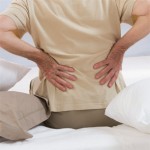Research suggests that physicians may find pain drawings particularly useful in discovering nonorganic factors affecting back pain.8 “If you have a drawing of someone and they note pain located in their low back, moving into their elbow and going down their arm to their fingers, and they identify these unrelated anatomical areas where they’re sensing discomfort, then you might suspect there’s a strong psychosocial component involved with their pain,” Dr. Richardson explains.
In fact, research indicates that psychiatric therapy may reduce back pain.4 Behavioral interventions also have proven useful for patients with chronic low back pain.9
Ultimately, a collaborative approach is ideal for a patient with rheumatic disease and back pain. A physical therapist will take several factors into account in creating an exercise plan for a specific patient, including where the pain is, the underlying cause, and other disease processes that may be in effect.
“Patients with rheumatic conditions can have several other comorbidities that may limit their ability to participate in certain exercises, and therapists are trained to tailor their exercise programs,” Dr. Goode says. A therapist also will help the patient progress through the program over time, as one exercise may become less effective as the treatment regimen progresses.
For example, patients who have AS “tend to get into this flexed position, losing the natural curvature of the spine, creating a lot of back pain,” Dr. Schoenhals says. “So if you find out early on they have this condition, a physical therapist can identify the most significant mobilization and strength deficits, and work with that individual to get on a good exercise program to keep their spine health and mobilization appropriate for as long as they can.”
In patients with RA, the cervical spine can be affected. If the patient has no instability and they don’t need corrective surgery, as determined by X-ray, a physical therapist can work with the patient on pain management, Dr. Schoenhals says.
For chronic pain that is not managed or improved with physical therapy and other conservative treatment, surgery or injections may be warranted, Dr. Goode says.
Surgery should be undertaken as a last resort, Dr. Richardson cautions. This is because even the pain of a herniated disk can be improved through physical therapy and a tailored exercise program. “You’d want to try a conservative course of pharmacology and nonpharmacology treatments, including physical therapy, and exhaust those possibilities and interventions before you refer [the patient] on to a surgeon.”


